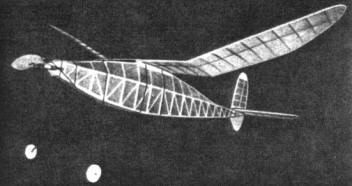|
The "OOMPH"FOR WINNING CONTESTS By AL CASANO
"OOMPH" is the name of the plane in this story, and that just about describes its characteristics, especially its climb. The author has used up a lot of patience, watching five of these planes fly out of sight, never to return, but among the laurels gathered by "Oomph" is the New Jersey State Championship, as well as numerous sectional meets. The crate is a model of consistency and has no bad flight tendencies. Ease of construction, ruggedness and consistent contest performance should make it worth the prospective builder's while. This job and its five lost brothers have had a total of twenty-three out-of-sight flights, ranging from fifteen to forty-two minutes, which eliminates the cry of "lucky." So let's go to work, remembering that the plane will be no better than the materials and care you put into it. Use the right grade and weight of wood in duplicate. By that we mean do not make one longeron out of rock-hard balsa then use soft stock for its mate, for such practice results in an out-of-line fuselage that does not improve with age. Fuselage Lay out the two sides of the fuselage in the conventional manner, using three-sixteenths square for the longerons and cross braces, and one-sixteenth by three-sixteenths for the diagonal braces. The two sides are then joined and the four formers, Fl, are cemented to the top. One-eighth hard is used to build up the turtle back, with one-sixteenth by three-sixteenth braces. Nose and tail boom sections are planked with one-eighth sheet. At the front of the fuselage, at the bottom, one-eighth square is cemented on as shown in the plans, to hold the landing gear in place in conjunction with elastic bands, which go around the fuselage. This makes the gear removable for convenience in transportation. The front and rear hooks are .050 wire and the tail boom is held on with Scotch tape. The nose block is three-quarters thick, shaped as shown, and eyelets are used to hold the thrust line right. The good old elastic band method holds the plug in after the power conks. The free wheeling is left to the personal preference of the builder, because of the wide variety of types and preferences. Rudder and Stabilizer The rudder is built up of one-eighth stock throughout, with solid one-eighth below the stab. Rudder is set at two degrees, to produce a right turn. The stab is made up of one-sixteenth ribs, with one spar at the bottom, of hard one-eighth square. This will produce a slight elliptical dihedral when covered and doped. Wing The wing tips, in common with the stab tips, can easily be plotted and the solid tip construction not only simplifies construction, but adds strength without adding too much weight. All ribs are one-sixteenth stock and four spars of hard one-eighth by one-sixteenth are used, the bottom rear spar being laid on the flat for ease in covering. There are two end wing panels, left and right, and a center panel, to which is cemented the wing saddle. The arrangement eliminates the sloppy winding of elastic around the whole works and lessens chances of the wing shifting in flight. A five inch dihedral under each tip insures good stability and climb on turns. Prop The propeller is small and is a one-bladed affair, which at first glance seems far too small for results. The proof of its efficiency is the terrific climb and the high ceiling attained before the rubber conks. Thirty strands of one-eighth flat, well lubed, drives the prop. Covering and Doping The color of paper is left to the inclination and taste of the builder. Don't try to cover everything with one piece; the secret of a good covering job is to use as many separate pieces of tissue as is necessary to eliminate wrinkles. Ingenuity helps a lot, too. Water spray, let dry, then give two coats of dope, watching out for warps when drying. Flying Glide the model in calm air, making any necessary adjustments by shifting the wing and warping the rudder, rather than changing the thrust line. After the glide is okay, put in about two hundred turns and try. Everything okay? Swell. Now "pack in" capacity, about seven hundred turns and be sure you have carfare to chase it. The climb is very fast and to the right and a ceiling that must be seen to be appreciated. The glide is also to the right and is slow both in forward motion and sinking speed. The average time on a cool calm evening is about three minutes. Remember, common sense and a little calm reasoning will do more to give you perfect flights than all the hot-headed outbursts against your plane on poor flights. Nine times out of ten it's the bone-headed tactics of the flier that are to blame. Good luck ! Scanned From July 1940 |
